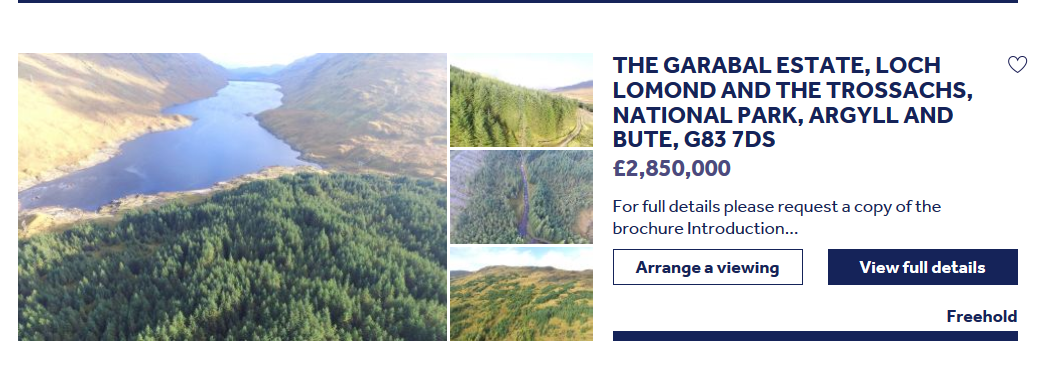
The Garabal Estate, which consists of a broad strip of land running south west from Inverarnan at the head of Loch Lomond is up for sale (see here for brochure). The asking price is c£652 an acre. This post takes a look at the issues this raises for the Loch Lomond and Trossachs National Park.
Background
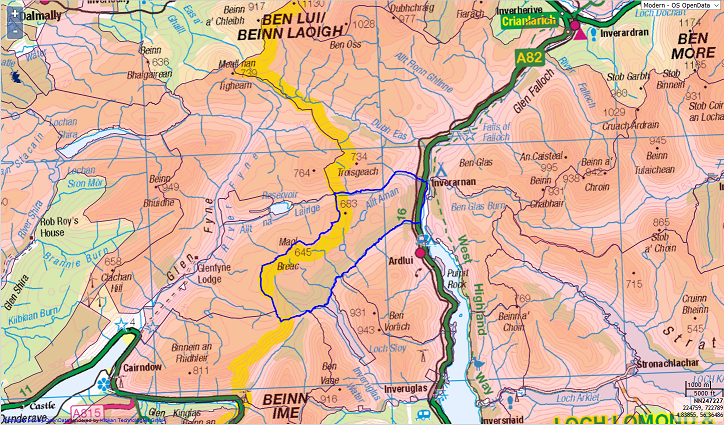
The estate is somewhat unusual as there is no lodge or other accommodation. It appears to have been primarily managed for forestry by its Danish Owners, Tuwo Daugard A/S, which is described as a forestry company.
“The afforested area totals approximately 557.05 hectares (32% of the overall land area),
of which 92% is Sitka spruce, 5% Sitka spruce mixed with larch, 2% Sitka spruce mixed with broadleaves and 1% which currently awaits replanting.” (Extract sales brochure)
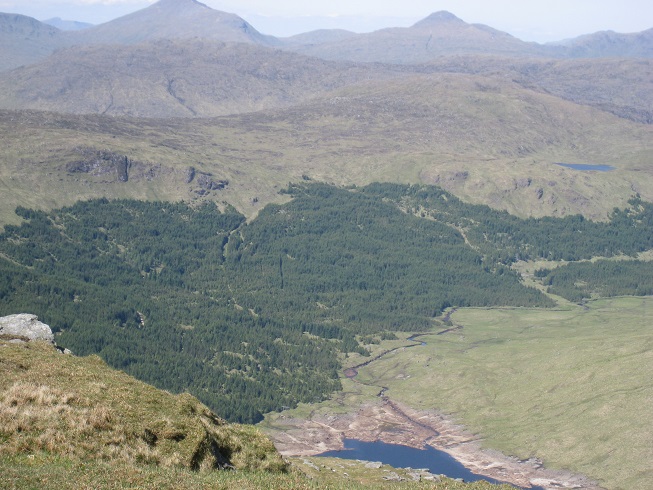
Most of the forestry on the estate appears to date from 1983, 20 years before the National Park was created.
The main access for the forestry plantations is via Glen Kinglas, north of the Rest and Be Thankful, up to the north end of Loch Sloy (the estate has a right of access through the Strone Estate). In 2010, however, when the National Park had been in place for seven years, the Forestry Commission gave consent for a new road access up from the east side of the estate south of the Drover’s Inn at Inverarnan. This further marred the landscape at the head of Loch Lomond:

To give the Loch Lomond and Trossachs National Park Authority credit, they have made some attempts to reduce the landscape scar created by the road. In 2011 and again in 2016 the Estate applied for and was granted Planning permission by the LLTNPA for a new house for an estate manager part way along this track. The house, constructed out of prefabricated cubes, has still not been built and planning permission is due to lapse this year. The Planners at the time, however, were concerned about the adverse landscape impact of the new road and granted planning permission subject to remedial works taking place.
The plantation in the photo could be mistaken, from a distance, as native woodland with open spaces dotted across the hillside. This, however, appears a case of nature getting the better of human intentions, the explanation being that the Sitka Spruce has taken with varying degrees of success. I have sought confirmation of this by asking for a copy of the Forest Plan which the estate agreed with Forestry Commission Scotland (not apparently available online).
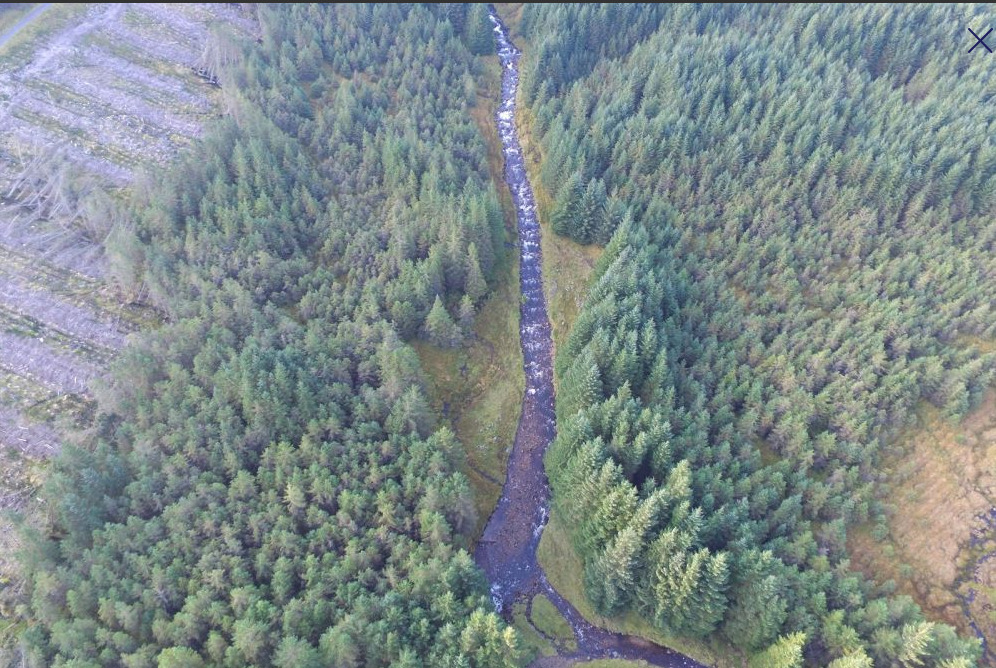
Photos from the sale brochure demonstrate the industrial nature of most of the forestry on the estate, with dense sitka plantations and clear fell.
The brochure, while full of the usual marketing speak, fails to mention the importance of Garabal Hill in the history of geology and our understanding of earth processes. The outcrops on the hill provide the best example of the varying mineral composition of granitic rocks which resulted from the Caledonian mountain building. They led a geologist called Nockolds to develop the theory of fractional crystallisation of magma chambers in 1941. This is now used worldwide to explain how different rocks precipitate out of molten magma at different temperatures and pressures. Its a world class geological site and Garabal Hill is designated as a Site of Special Scientific Interest as a result. That has not prevented conifers being planted over at least one of the important outcrops
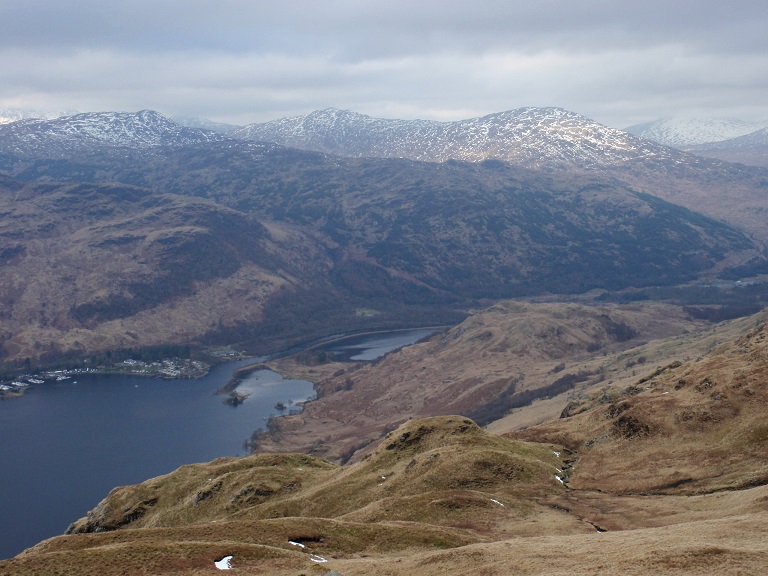
How the Garabal Estate is being marketed
Bidwell’s describes itself on its website as the largest independent property consultants outside of London and as “well informed”.
Designations and Listings
Garabal is situated entirely within the Loch Lomond and Trossachs National Park. There is a geological SSSI on Garabal Hill in addition to different sections of the Estate falling within a Special Area of Conservation, Special Area of Protection, National Nature Reserve and RAMSAR site, further details of which will be made available via a secure data room (extract brochure).
This is wrong. While referring to the geological SSSI NONE of the Garabal Estate is a Special Area of Conservation, National Nature Reserve or RAMSAR site. This can be easily confirmed on SNH sitelink (see here) or indeed by reading the LLTNPA’s reports on the Planning Applications for the new house 2016_0259_DET-Delegated_report_final-100272188 .
The mistake, however, is in a sense irrelevant for Bidwells appear to attach no significance to these conservation designations. There is no explanation to prospective buyers about how any of the statutory designations or the four statutory objectives of the National Park, the first of which is conservation, should inform the management of the land. Instead the suggestion in the brochure is that a new landowner can set their own objectives:
“options for a new owner to mould the forest management to meet their own objectives may present themselves when the Forest Plan comes to be updated and renewed in 2020.”
Bidwell’s focus and target audience is people who see the estate as an opportunity to make money out of forestry and to develop “sporting” interests:
“The Estate offers an attractive mixture of mainly afforested lower slopes running the length of its southern and eastern boundaries and open hill deer forest which dominates the northern two thirds of the Estate. There are also two elevated lochs, Lochan Srath Dubh-uisge and Lochan Beinn Damhain which offer truly wild trout and char fishing opportunities.”
“Harvesting of sections of the commercially productive crops could provide a realisable income stream in the near future as the trees reach financial maturity.”
Note, its all about “financial maturity”. Not only that but the land
“offers the sporting enthusiast an opportunity to develop and capitalise on the inherent potential of the Estate”.
As further enticements there are also references in the brochure to a preliminary report into the feasibility of a hydro scheme, which literally provide licenses to the rich to print money, and a minerals exploration report which was prepared in 2013 and identified potential gold deposits.
Where is conservation, enjoyment by the public, sustainable development or wise use of resources evidenced in any of this?
So how effectively are our public authorities trying to influence how the Garabal Esate should be managed?
There are three main public authorities with an interest in Garabal, Scottish Forestry, the new forest regulator in Scotland, Scottish Natural Heritage and the LLTNPA. The main interest of all three at present appears to relate to forestry. This is reflected in the new Woodlands and Trees Strategy for the National Park which is currently out for consultation (see here). (The consultation closes Monday)
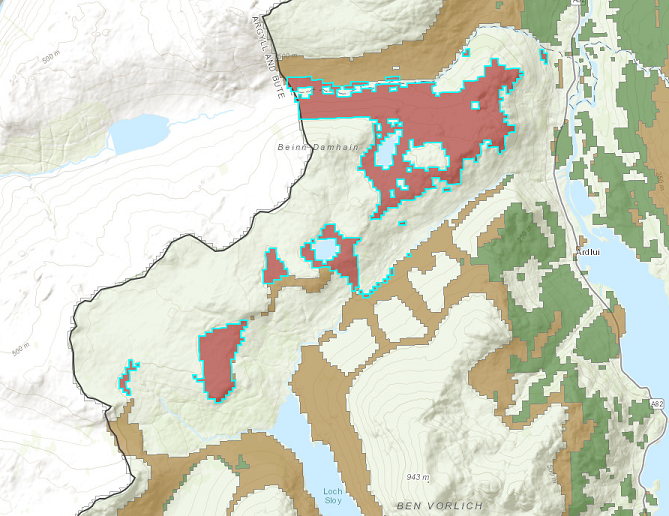
The map extract is striking for two reasons. First Garabal is almost the largest area within the National Park which is labelled as “sensitive” to woodland creation, ie where woodland planting won’t be supported.
![]() The area on the map incorporates some of the geological Site of Special Scientific Interest but also additional land to the west.
The area on the map incorporates some of the geological Site of Special Scientific Interest but also additional land to the west.
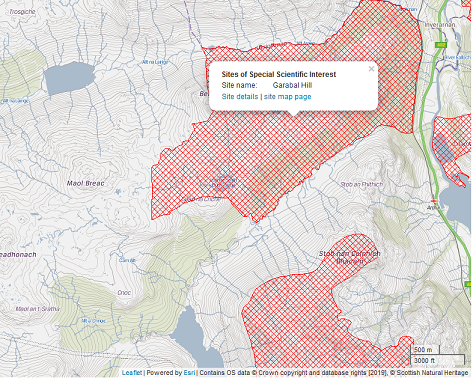
Second, the LLTNPA map fails show any of the existing plantations on the estate (which are well shown on the SSSI map above) but instead leaves them blank rather than areas where native woodland could be created. The implication is that Scottish Forestry, the successor body to Forestry Commission Scotland, does not believe any of the intensive forestry plantation on the estate should be diversified, as is advocated in the LLTNPA’s draft Woodland Strategy. Instead, its vision appears firmly focussed on replacing sitka with sitka. This is confirmed by the brochure:
There are existing obligations to replant 7.90 hectares of woodland in 2020-2021. The purchaser will be required to take over all commitments, including replanting and sign a form of undertaking (FGS successor request form).
To make matters more complicated, its not clear how the Forest Plan 2010-20 agreed by Scottish Forestry (which I have asked for) fits with the (very dated) Management Agreement SNH signed with the estate back in 1992 to allow access to the estate to study rock exposures. This was drawn up AFTER the major planting had taken place on a large chunk of the SSSI and lasts until 2035. According to SNH’s current Site Management Statement “Some of the forest covers areas of crucial rock exposure”. Whether or how this is being addressed is not clear.
The picture is one of all our Public Authorities doing their own thing on forestry with little sign of join up. Forest Scotland wants more sitka, SNH to keep the area tree free while the LLTNPA would like more native woodland but has abandoned this patch to the other two auhtorities. The lesson for the LLTNPA’s draft Woodland Strategy is unless it incorporates clear spatial plans showing all woodland, both existing and proposed, and unless it incorporates mechanisms to reconcile conflicting interests its unlikely to deliver the statutory objectives of the National Park. This lack of joined up thinking helps allow landowners and their agents, in this instance the Garabal Estate and Bidwells, to continue to do what they want and ignore the statutory objectives of the National Park Authority.
Red Deer provide another example of how our public authorities have failed to get the Garabal Estate to do the right thing. The Bidwell’s brochure reveals:
The late 1980’s saw an average annual red deer cull of 38 stags and 21 hinds, while in the late 1990’s annual culls of roe deer averaged 10 bucks and 10 does. Scottish Natural Heritage have
advocated an increased red deer cull, therefore it is considered there is potential to increase the annual cull level above those achieved in recent years, during which the current owner has carried out stalking on a relatively low-key basis without any commercial targets.
In other words the estate has NOT controlled deer numbers. The consequence, which is unstated, is that high deer numbers continue to prevent native woodland from regenerating naturally and have impacted on neighbouring protected areas which are in “unfavourable condition” due to overgrazing! In return for failing to control deer numbers the brochure indicates that “The assessors have assigned a rateable value to the sport of £3,450.” A small price to pay to be allowed to do what you want.
That there is such a conservation shambles is hardly surprising when, back in 2016, when I complained about the abandoned car on the Garabal Estate, the LLTNPA’s reply suggested that they did not know how to contact the landowner (see here). If the LLTNPA has no contact for landowners, how can they possibly influence them?
An alternative vision for land ownership and land management in the National Park
Scotland’s National Parks are almost unique in world terms in allowing land to be owned privately and then traded between private buyers without any reference to our National Parks’ statutory purpose. A system that put the National Park’s statutory objectives first would at the very least require the owners of landed estates to be approved as fit to own and manage land in our National Park. The converse of this is that our National Park Authorities should have powers to remove landowners who are judged unfit to manage the land (see here) and (here). We should not be allowing estates like Garabal to be traded and managed in the way they are at present.
Garabal is an opportunity waiting to happen.
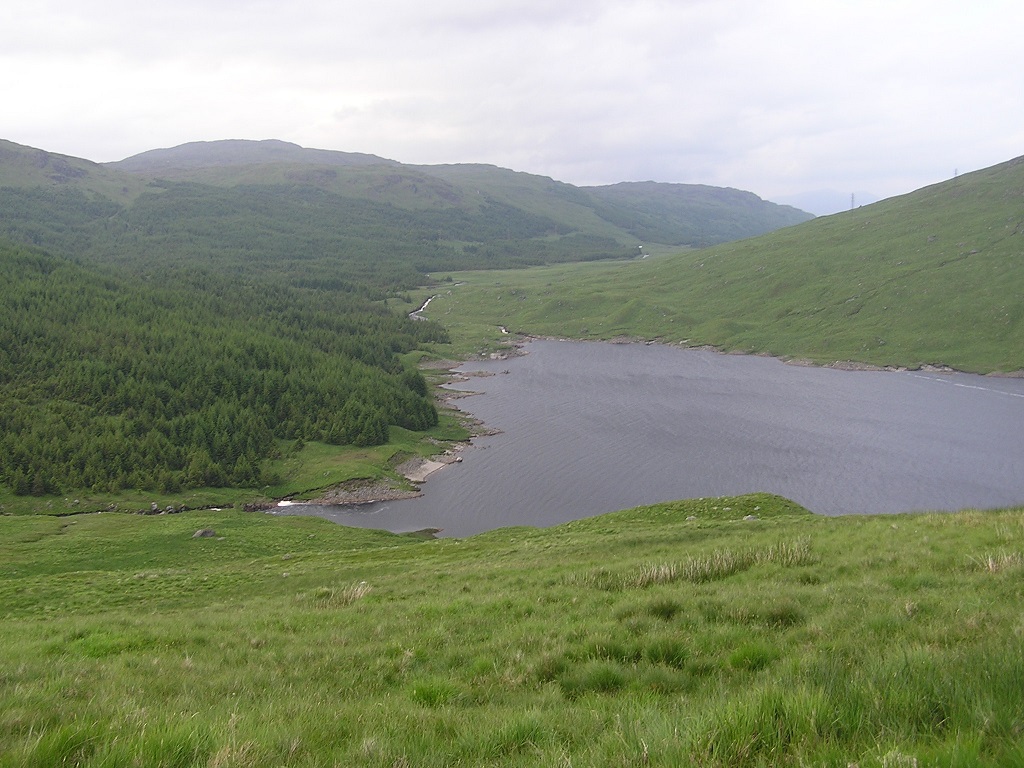
Think landscape, how we should address the blanket blocks of forestry, ugly hill roads and electricity infrastructure that mars the estate.
Think wildlife, how control of deer numbers, removal of plantations and regeneration of native woodland could bring birds, animals and plants back into the area.
Think about how the National Park could be creating native wood networks, joining the Oak woodlands to the west and Loch Lomond, instead of which we have a strip of conifers.
Think people’s enjoyment, a popular guide to the geology of Garabal Hill, the potential for through routes, wildlife watching or wild camping.
Think employment and housing, creating jobs where the people who work the land have secure jobs and are able to live in the National Park
Think climate change, the role of woods in absorbing carbon, providing renewable fuel and a sustainable source of timber for Scotland (there is a place for conifer forestry, just not blankets of the stuff).
Why can’t our National Parks grab the opportunities and make the argument that land like Garabal needs to be managed differently and who does so should not be decided on the open market. That should mean conservation ownership, whether by themselves, a conservation organisation or an enlightened landowner like Anders Povslen.

Seems an ideal opportunity to return the land to public ownership. Why isn’t that policy in national parks?
Why not buy it with your own funds? Leave mine out of it. Taxpayers should not be funding land purchase.
Why not? Land in most other National Parks in the world is publicly owned.
Better to ask the government to look after the land, via the national parks, than stand by and let irresponsible land owners misuse it – or didn’t you read Nick’s article before posting? Instead of sharing your political credentials why not respond to Nick’s reasoned arguments?